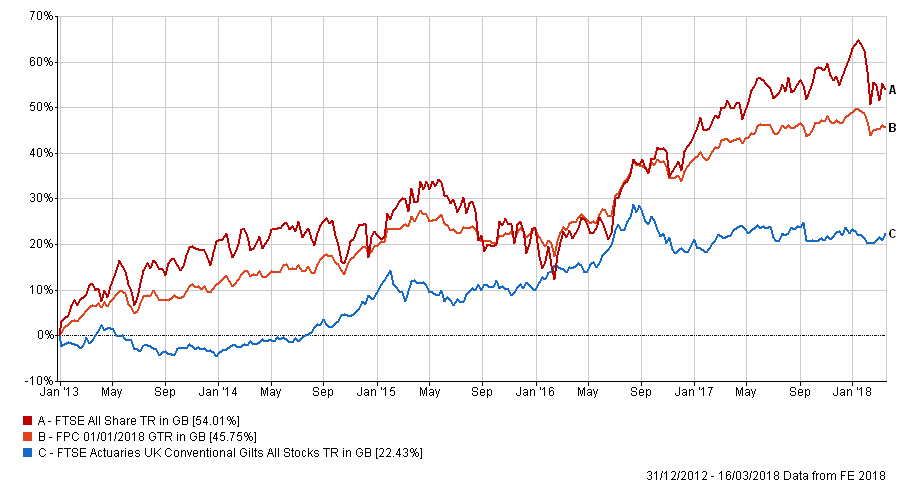Insights from our quarterly investment review
A look back at the last five years; and how our portfolios are currently positioned
Looking back
2017 was another strong year for ‘growth’ assets, with UK commercial property performing well and double-digit returns for most stock markets. In contrast the ‘defensive’ assets in most portfolios were flat: government bonds returned just under 2% and cash even less.
Overall, investors have experienced good returns over the last five years, driven by the performance of global stock markets which have gone up in value considerably in this period.
The FPC portfolio shown in orange is representative of the investment experience of our clients. It’s updated quarterly and reflects our asset allocation and fund selection policies, and also the time taken to implement changes. The UK stock market is shown in red and government bonds in blue – we’ve plotted a course through the middle.

Past performance doesn’t predict or guarantee future returns. Investments can go down as well as up in value and you may get back less than you put in. The FPC portfolio is not representative of any individual’s investment experience. Returns are net of fund costs, but not platform or adviser charges, or tax. These will reduce the value of your investment.
Current positioning
We made no changes to our asset allocation policy at our last meeting.
The investment committee’s guidance is that a typical medium-risk long-term portfolio should have between 40-55% in fixed interest investments (such as government and corporate bonds) and 45-60% in ‘growth assets’ – predominantly shares.
The weighting to UK shares is 10-15% of the total, but that includes companies that derive most of their earnings overseas. So in practice the global reach is broader.
In fact, we’ve gradually been reducing our exposure to the UK stock market over time – five years ago, the total was around 25-30%. We’ve also reduced the amount in ‘high yield’ bonds, from around 10% to 0%.
All client portfolios are well-diversified. For example, the largest individual stock in the FPC portfolio shown here is BP, at 0.6%. So if the company’s share price halved, an investment of £100,000 (in the portfolio) would go down in value by just £300.
Looking forward
Recent stock market volatility has reminded us that the experience of the last five years is unusual.
We asked independent economic consultant Peter Stanyer to share his thoughts on potential threats to wealth in 2018 and beyond.
You can read his analysis here:
Peter Stanyer is co-author with Professor Stephen Satchell of The Economist Guide to Investment Strategy, 4th edition, Profile Books, 2018. Peter is an independent economic consultant to the Financial Planning Corporation LLP. The views expressed are his own personal views, and do not constitute advice to buy, sell or hold any investment.
Peter’s comments highlight that, as ever, we don’t know what the future may bring – there are too many variables. And we can’t be sure how markets will respond even to the ‘known unknowns’ on the horizon.
But we do know that well-diversified investors with the right risk profile (for them), and with sufficient cash to stay the course during bad times are best placed to meet their long term goals.
As always if you need further clarification or explanation do call us.





